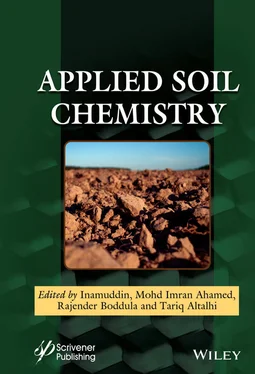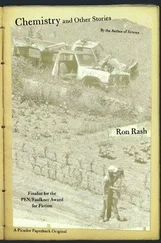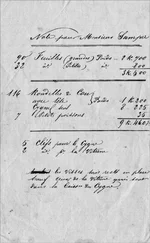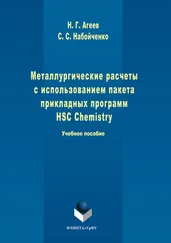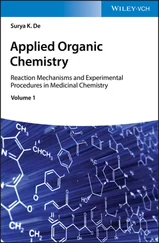Material pH value and water moving through it has a considerable role in the nature and rate of chemical weathering. As per Jackson et al ., in the year 1948 [38], it was reported that the enhancement in acidity has a positive contribution in the rate function of weathering. Graham et al ., in the year 1941b [81–83], reported feldspar faster decomposition when acidified clay is present. The procedure shows faster elimination of cations (metallic) by exchange materials and simultaneously hydrogen is released during the process of hydroxylation reaction as the product of weathering. Additionally, with acid saturation exchange, also the influence of specific acid likes sulphuric and carbonic acid should be under consideration. Truog and Attoe et al ., in the year 1946 [84–86], reported release of potassium dilute acid from soil. Loss of mica and depotassication, with increment in kaolinite and vermiculite are highly enhanced with the arrival of leaching, which lowers the pH of the soil lower to 7, as reported by Jackson and Hseung in the year 1952 [87–89]. Gibbsite and kaolinite are formed because of the enhancement of the acidic condition of soil, in case of minerals containing high quantity of silica. This was explained by Hendricks and Ross et al . [90–92], in the year 1945, as high rate of elimination of silica and metallic ions due to leaching prior to recombination with sesquioxides. Even though, boehmite, gibbsite, and kaolinite are structurally hydroxyl compounds, but they act chemically like acid anhydrides or insoluble weak acids, weaker in comparison to silicic acid.
2.3.2.4 Biotic Processes Factor
Biotic processes in case of chemical weathering can be discussed in two sections. One is organic residue effects and other is ionic uptake cycles. Plants which are very tall physically affects chemical weathering by increasing the size of the cracks in rocks, as a result of which movement of water is easier and also it shades the soil, thereby affecting evaporation and soil temperature. High plants as well as microorganisms fasten the nutrients release from minerals through exchange of hydrogen ions with minerals charge and absorption. According to Bastisse and Demolon et al . in the year 1946 [1], it was reported that plants were one of responsible factors of weathering owing to the fact that soil planted with trees released higher quantity of potassium in comparison to unplanted soil. Jackson and Hseung et al ., in the year 1952 [87], reported that soil acidity accumulation is followed by micas depotassication. As per Kellog et al ., in the year 1943 [16], it was reported that in case of bare soil or virgin soil due to vegetation nutrients are returned as organic residue to the soil surface. Organic matter accumulation on the surface of the soil has considerable impact on the minerals weathering, either by distribution of aluminium oxide and iron present in soil or by bases leaching. As per Kanehiro and Sherman et al . in the year 1948 [99–101], it was reported that ferns present in regions of tropical humid Hawaii, below highly acidic forest floor have reactions in the pH range between 3 and 4,which is relative to the white pine forest floor the zone of cool temperate region. The organic matter mixed with soil controls the rate of chemical weathering and loss of bases. The rate of chemical weathering is faster in case of highly acidic forest floor in comparison to alkaline or neutral forest floor. Some kinds of organic matter, specifically organic acids, give rise to formation of complex with sesquioxide ions and transfer them to subsoil from the upper horizon and little amount inside the ground water. Elimination of iron out of ferromagnesian minerals is increased owing to this activity. The overall process of weathering as reported by Jackson and Hseung in the year 1952 [16] was influenced because of elimination of iron oxides from horizon A and accumulation in horizon B. As per Vagelor et al ., in the year 1933 [102–104], and Mohr et al ., in the year 1944 [96], it was reported that in tropical areas vegetal canopy is highly significant. According to Mohr et al ., in the year 1944, it was reported that air temperature above the soil is considerably less in case of canopy forest. Similarly, soil enveloped by forest has 10°C to 15°C. The decrease in the temperature makes all the chemical reaction slower. Organic matter decomposition is slower, causing deposition of organic substances either in or at horizon surface. The condition in deciduous tropical forest and evergreen tropical forest is considerably different. Gupta and Griffith et al ., in the year 1947 [105], reported that when teak is planted in laterite soil then a crust of laterite is formed due to the soil dehydration during the dormant leafless stage or drought period. The laterite soil formed hampers the tree growth. Sherman et al ., in the year 1953 [106], verified these findings in case of Hawaiian Islands.
2.3.2.5 Reduction and Oxidation Factor
Reduction and oxidation reaction influences the process of chemical weathering. As per Jackson et al . in the year 1948 [37], in equation of weathering, positive sign is assigned to oxidation. Hence, iron occurrence in ferrous state or reduction favoring conditions enabled the formation of montmorin in the intermediate stage of weathering as per Wendricks and Ross in the year 1945 [107]. Moreover, occurrence of iron in ferric state or oxidation favoring conditions favored free oxides and kaolin formation in higher weathering stage. According to Marshall and Humbert et al ., in the year 1943 [13], oxidation role in weathering was reported as ferric oxide formation in quartz grains cracks which breaks the quartz crystal. Oxidation rate also has an impact on the accumulated organic matter prevailing in soil which ultimately influences the rate of chemical weathering.
2.3.2.6 Influence of Time on the Rate of Chemical Weathering
According Jackson et al ., in the year 1948 [37], it was reported that for a particular particle size range and mineral species, the stages of weathering of the colloid weathering are the result of time duration of weathering and intensity function multiplication. Thorp et al ., in the year 1944 [108], reported that soils present in some of the mountain displayed considerable development of soil and weathering after a particular duration of time. Retzer et al ., in the year 1949 [63], reported great significance of the age of the mineral weathering and formation of dense, unique subsoils which are oftenly highly thick in case of Rocky Mountains of Central Colorado. The time of exposure or age exhibits crucial part for determining the type of mineral existing at a particular time in tropical soils. Mohr et al ., in the year 1944 [96], reported five stages of weathering for the development of tropical soils. The stages include the following:
Beginning stage (unweathered virgin material)
Juvenile stage (point where there is beginning of weathering)
Virile stage (in this stage, the weathering is in highly advanced stage where the percentage of unweathered material is negligible)
Senile stage (at this point, there is completion of unweathered material weathering)
Final or end stage (at this point, development has reached to completion and the soil has been weathered.)
The above proposal displays that the weathering of mineral which contributes in formation of soil remains in equilibrium (dynamic) with the factors prevailing in the environment. According to the above proposal, at the final stage, there is the establishment of static equilibrium.
Читать дальше
